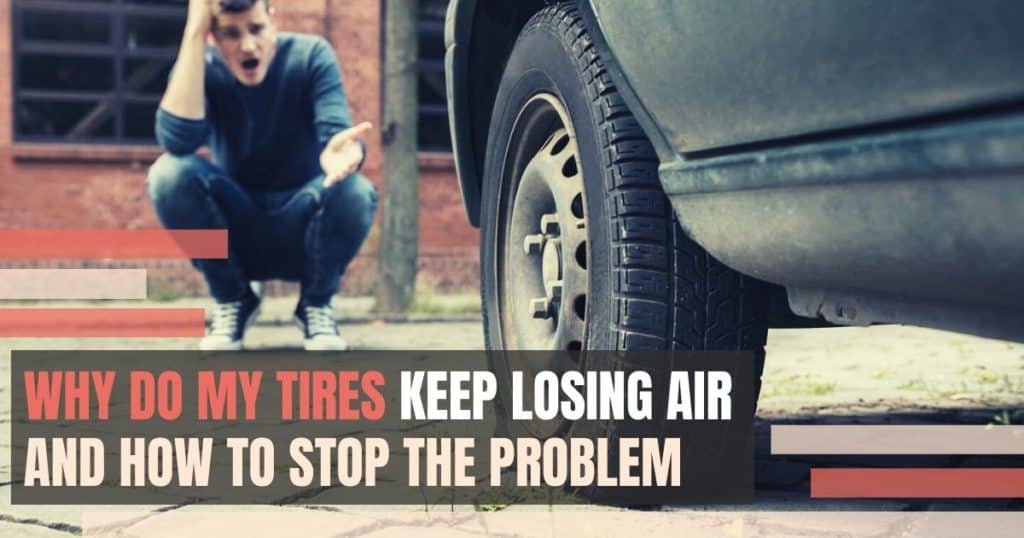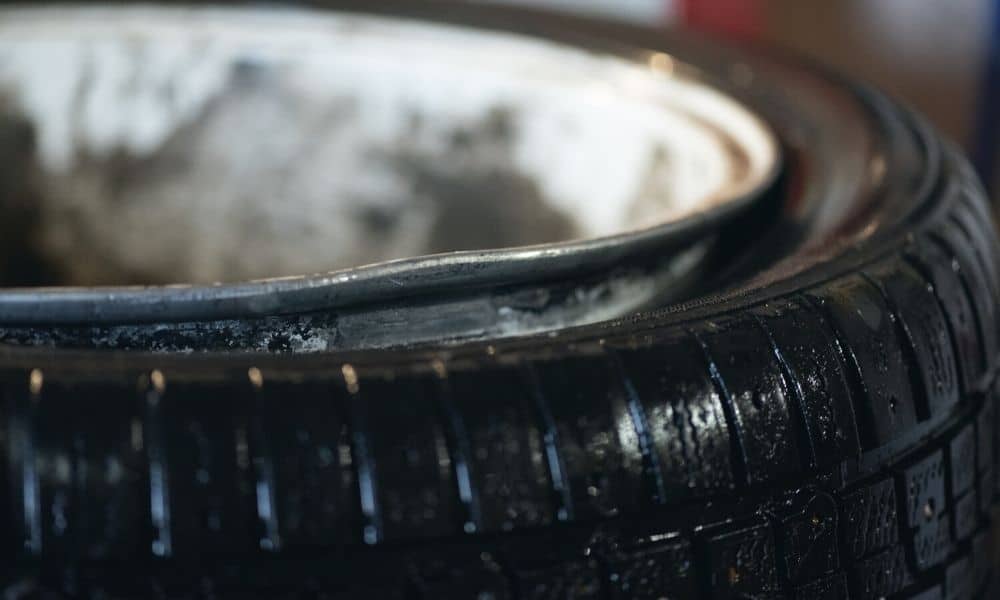All tires lose air over time. It is normal to see a loss of one to three pounds per square inch (PSI) over the course of a few months. If your tire is showing a more aggressive leak it may be the result of wheel damage, tire damage, changes in the temperature, etc. Understanding the root cause of your air leak can help you address the issue. For any air issues with your tires you need to fix them quickly to ensure your vehicle is safe. So if your tires keep losing air, follow along below as we address the primary reasons for air loss and how to identify the issue and stop it.
Why Do My Tires Keep Losing Air?
There are three main sources that contribute to air loss in your tire: damage to the wheel, damage to the tire, and changes in temperature.
Damage to the Wheel
If there are problems with the wheel, also known as the rim, air can leak slowly. Two common problems are associated with the wheel:
- Failing Valve Stem: Valve stems are the rubber piece that protrude from the rim that contain the nozzle you put air into. Overtime these can deteriorate due to their exposure to the sun and chemicals from the road. When you buy new tires, you typically get new valve stems as well. If you notice a slow air leak more then a few PSI per month, you may need to replace the valve stem. You can actually cause a leak by over tightening the cap on the valve core.
- Damaged or Bent Rim: If you have hit something like a pot hole hard your wheel can get bent and lose it’s circular shape. This is a common cause of air loss. It can be more impacted if there is corrosion on the wheel where the tire is mounted. If you notice that your vehicle has a vibration when you drive, and your tire is leaking air, it’s possible a bent wheel is the root cause.
Damage to the Tire
Tire damage is another common reason that your tires keep losing air. Here are four problems associated with the tire:
- Nails: Nails or any sharp object can puncture your tire and cause it to lose 2-3 PSI daily. Sometimes when a nail is your tire, the leak may seem slow, but regardless you need to have it fixed. For a puncture, the air leak is only one concern, but getting a flat tire is another.
- Bead Damage: The bead is where the tire and wheel seal together. The bead can chunk up and result in an air leak. This chunking of the rubber creates a gap between the rubber tire and the metal rim in which air leaks out of.
- Tire Aging: When a tire gets old, it gets weak and the elasticity of the rubber gets stretched. This can also cause bead damage, that is harder to see then chunking. It is similar in that it creates a gap between the tire and rim that causes a loss of air.
- Road Hazards: Hitting something hard with your tire like a curb or pothole can cause a loss of air. Even if the tire and wheel are not damaged in the incident, it could mean you lost some pressure. Anytime you hit something hard with the tire, you need to inspect it for sidewall bulges, cuts, and punctures. These are more severe signs of air loss.
Changes in Temperature
Interesting fact: A tire loses 2% of the total air for every 10°F drop in temperature. Conversely it comes back up 2% with every 10°F increase in temperature. A car for example could lose about 1 PSI in a weather shift and a truck 2 PSI. Considering in the US the weather can change almost 20°F when the sun goes down you may find your PSI lower in the AM. Your change in temperature may have caused the PSI to drop, but if you wait until noon, you will have seen it come back.
Temperature and pressure changes are not your tire losing air. It’s just that air constricts when cold and expands when warm. The amount of pressure in your tire though is actually still the same.
How to Find The Leak When Your Tires Keep Losing Air…
There are three common ways to identify where a tire may be losing air from…
- Listening to the Tire and Feeling for Air: If air loss is drastic enough you may hear a hissing sound coming from the tire. You can put your ear neat the tire and listen to wear the air may be pushing out from. If you can hear the leak, confirm it, by placing your hand over the spot you hear the hissing. You will likely feel a small bit of air on your hand. Additionally you can feel for heat. When air pushed out from the rubber, it causes the rubber to heat up. The place with the leak should be warmer then the rest of tire.
- Soapy Water Method: Take a spray bottle and fill it with soapy water. Spray the tire tread and edge of the wheel. Even spray the valve stem. You can pour the soapy water straight onto the sidewall. You need to look for bubbles in the water. Bubbles are the tell take sign of where you are losing air. If you don’t see bubbles immediately wait a few minutes and keep looking. It sometimes takes a few minutes to manifest,
- Dropping the Wheel in Water: This is not the most practical solution, because you need to completely remove the tire from the vehicle. When you submerge the tire in water, you will see bubbles produced where the leak is. If you don’t see air bubbles right way wait a few minutes. If you still don’t see bubbles, flip the tire over and check the other side.
Using soapy water is not only the most practical method, but it also often reveals small punctures.
How to Fix the Leak if Your Tires Keep Losing Air
If your tires keep losing air, you need to address the root cause of the issue.. Depending on the reason for the air leak, not every issue is actually fixable. There are temporary solutions you can use, but these still need to be treated at a tire repair place near by. You can’t just keeping pumping air into it at the gas station and hoping it will go away…
Fixing the Tire
If you have tire damage you can take it to a repair shop or fix the tire yourself. The two options are sealants or plugs. You should only repair tires with puncture on the tread. If you have a damage to the sidewall you need to get a new tire and not drive on the damaged tire.
- Sealant: To use a sealant requires a pressure gauge, air pump, and a sealant. A sealant creates a layer of protection inside the tire. When you add air from the pump, the pressure inside pushes the sealant into the puncture from the inside and forms a bond. Using sealants should be a temporary solution.
- Plugging the Tire:A plug kit is easy to use and can be ordered online. They come with everything you need like plugs, reaming tool, T-Handle, and rubber cement. The only additional thing you may need is pliers and some good old fashion strength to pull the nail from the tire.
- Pathing the Tire: A patch is a better solution then a plug. They last longer and create a better bond with the rubber through a process called vulcanization. The best solution is a plug with a patch on top of it.

Flat car tire repair kit Tire plug repair kit for tubeless tires.
Fixing the Valve Stem
Fixing the valve stem involves a valve removal tool and a new valve core. If there is corrosion you need to clean it before replacing the stem. Any time you replace a stem you need to work protective goggles.
Fixing the Wheel
Wheel damage, like a bent rim, it is much more difficult to address on your own. This is better to to a wheel repair shop where they have the proper tools to straighten it. You never should hammer a rim to get it straight, you will do more harm then good.
The only thing I would suggest you do for wheel damage is remove corrosion. You can take the wheel off the vehicle and remove the tire. You can sand the rim and then apply aluminum metallic polish. In the same vein you can also consider pwder coating the rim, that will protect the rim, but not do much for air loss.
Regular Inflation Maintenance
Checking the inflation on your tire routinely is important. It is a tire basic that every driver should understand. If you purchase used tires, I would encourage you to check more frequently. You should always check tire pressure when they are cold. Tires that have been driven on or that have been sitting in the sun will give a +2 higher PSI reading.
Additionally if your vehicle has TPMS on it, it can actively monitor your tire pressure and let you know when you are low.
If the root cause of the air lose has been addressed you can also consider getting your tires filled with nitrogen. Nitrogen is a denser gas and therefore keeps your tire inflated longer even when there is a small air leak. The gas leaks much slower then oxygen.
How Do I Find My Recommended Tire Pressure PSI?
There are three places you can find your vehicles recommend PSI. The vehicles owners manual, on the drivers side door jam sticker, and on the internet. Never use the PSI number from the tire, you need the recommended amount for your vehicle.
Why You Must Prioritize Tire Pressure
Tire pressure is critical for several reasons: Traction, treading water, stopping distances, handling, stability, load capacity, tire longevity, and fuel consumption.
Tires Keep Losing Air – Wrap Up…
When you don’t have the right pressure in the tires the vehicle is less stable and you can get flats or even blowouts. Over inflation is not nearly as dangerous as under inflation. For a car the avg is approximately 35 PSI and anything below 28 starts getting dangerous. So if you have leak that is dropping your pressure more then 5-7 PSI, you need to take care of it right away. If your tires keep losing air, you can’t just keep feeling it with air because it will keep leaking. You need to address the root cause.

